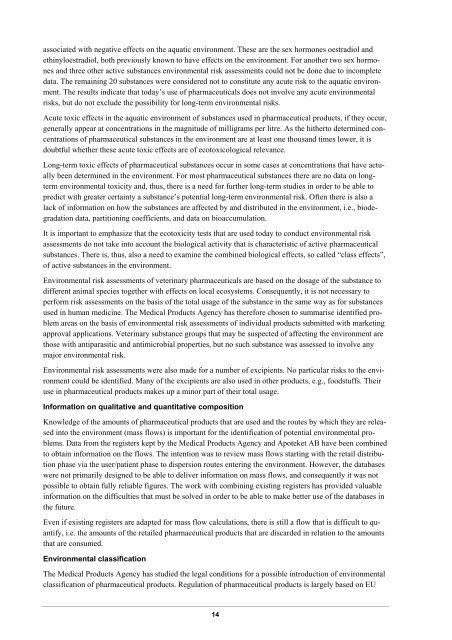040824_miljouppdraget-rapport
040824_miljouppdraget-rapport
040824_miljouppdraget-rapport
Create successful ePaper yourself
Turn your PDF publications into a flip-book with our unique Google optimized e-Paper software.
associated with negative effects on the aquatic environment. These are the sex hormones oestradiol and<br />
ethinyloestradiol, both previously known to have effects on the environment. For another two sex hormones<br />
and three other active substances environmental risk assessments could not be done due to incomplete<br />
data. The remaining 20 substances were considered not to constitute any acute risk to the aquatic environment.<br />
The results indicate that today’s use of pharmaceuticals does not involve any acute environmental<br />
risks, but do not exclude the possibility for long-term environmental risks.<br />
Acute toxic effects in the aquatic environment of substances used in pharmaceutical products, if they occur,<br />
generally appear at concentrations in the magnitude of milligrams per litre. As the hitherto determined concentrations<br />
of pharmaceutical substances in the environment are at least one thousand times lower, it is<br />
doubtful whether these acute toxic effects are of ecotoxicological relevance.<br />
Long-term toxic effects of pharmaceutical substances occur in some cases at concentrations that have actually<br />
been determined in the environment. For most pharmaceutical substances there are no data on longterm<br />
environmental toxicity and, thus, there is a need for further long-term studies in order to be able to<br />
predict with greater certainty a substance’s potential long-term environmental risk. Often there is also a<br />
lack of information on how the substances are affected by and distributed in the environment, i.e., biodegradation<br />
data, partitioning coefficients, and data on bioaccumulation.<br />
It is important to emphasize that the ecotoxicity tests that are used today to conduct environmental risk<br />
assessments do not take into account the biological activity that is characteristic of active pharmaceutical<br />
substances. There is, thus, also a need to examine the combined biological effects, so called “class effects”,<br />
of active substances in the environment.<br />
Environmental risk assessments of veterinary pharmaceuticals are based on the dosage of the substance to<br />
different animal species together with effects on local ecosystems. Consequently, it is not necessary to<br />
perform risk assessments on the basis of the total usage of the substance in the same way as for substances<br />
used in human medicine. The Medical Products Agency has therefore chosen to summarise identified problem<br />
areas on the basis of environmental risk assessments of individual products submitted with marketing<br />
approval applications. Veterinary substance groups that may be suspected of affecting the environment are<br />
those with antiparasitic and antimicrobial properties, but no such substance was assessed to involve any<br />
major environmental risk.<br />
Environmental risk assessments were also made for a number of excipients. No particular risks to the environment<br />
could be identified. Many of the excipients are also used in other products, e.g., foodstuffs. Their<br />
use in pharmaceutical products makes up a minor part of their total usage.<br />
Information on qualitative and quantitative composition<br />
Knowledge of the amounts of pharmaceutical products that are used and the routes by which they are released<br />
into the environment (mass flows) is important for the identification of potential environmental problems.<br />
Data from the registers kept by the Medical Products Agency and Apoteket AB have been combined<br />
to obtain information on the flows. The intention was to review mass flows starting with the retail distribution<br />
phase via the user/patient phase to dispersion routes entering the environment. However, the databases<br />
were not primarily designed to be able to deliver information on mass flows, and consequently it was not<br />
possible to obtain fully reliable figures. The work with combining existing registers has provided valuable<br />
information on the difficulties that must be solved in order to be able to make better use of the databases in<br />
the future.<br />
Even if existing registers are adapted for mass flow calculations, there is still a flow that is difficult to quantify,<br />
i.e. the amounts of the retailed pharmaceutical products that are discarded in relation to the amounts<br />
that are consumed.<br />
Environmental classification<br />
The Medical Products Agency has studied the legal conditions for a possible introduction of environmental<br />
classification of pharmaceutical products. Regulation of pharmaceutical products is largely based on EU<br />
14




